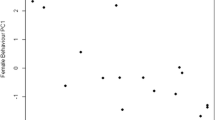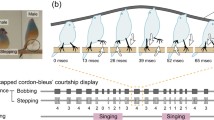Abstract
As a cephalopod, Octopus vulgaris is capable of the fastest and some of the most varied colour changes in the animal kingdom ; yet there is a remarkable lack of evidence for these being used in courtship or mating displays of the kind associated with brightly coloured vertebrate animals. Courtship colour display by a less studied octopus (probably O. horridus) has been observed by Young1, and the dramatic ‘zebra’ pattern of the decapod, Sepia offitinalis, which is used both in courtship and as a threat between males, is well known.
Similar content being viewed by others
References
Young, J. Z., “Courtship and Mating by a Coral Reef Octopus O. horridus” (unpublished).
Aristotle, see D'Arcy Thompson's The Works of Aristotle translated into English, Book V, 6, 541b (Oxford 1910).
Racovitza, B. G., Arch. Zool. Exp. Gen., 2, 23 (1894).
Wells, M. J., and Wells, J., J. Exp. Biol., 36, 1 (1959).
Boycott, B. B., and Young, J. Z., Pubbl. Staz. Zool. Napoli, 27, 232 (1955).
Young, J. Z., Proc. Roy. Soc., B, 149, 463 (1958).
Author information
Authors and Affiliations
Rights and permissions
About this article
Cite this article
PACKARD, A. Sucker Display of Octopus . Nature 190, 736–737 (1961). https://doi.org/10.1038/190736a0
Issue Date:
DOI: https://doi.org/10.1038/190736a0
- Springer Nature Limited
This article is cited by
-
The making of an octopus arm
EvoDevo (2015)
-
Cephalopod neurobiology: an introduction for biologists working in other model systems
Invertebrate Neuroscience (2013)
-
Light-emitting suckers in an octopus
Nature (1999)
-
Ventilation rate and copulation in Octopus vulgaris
Marine Biology (1973)





